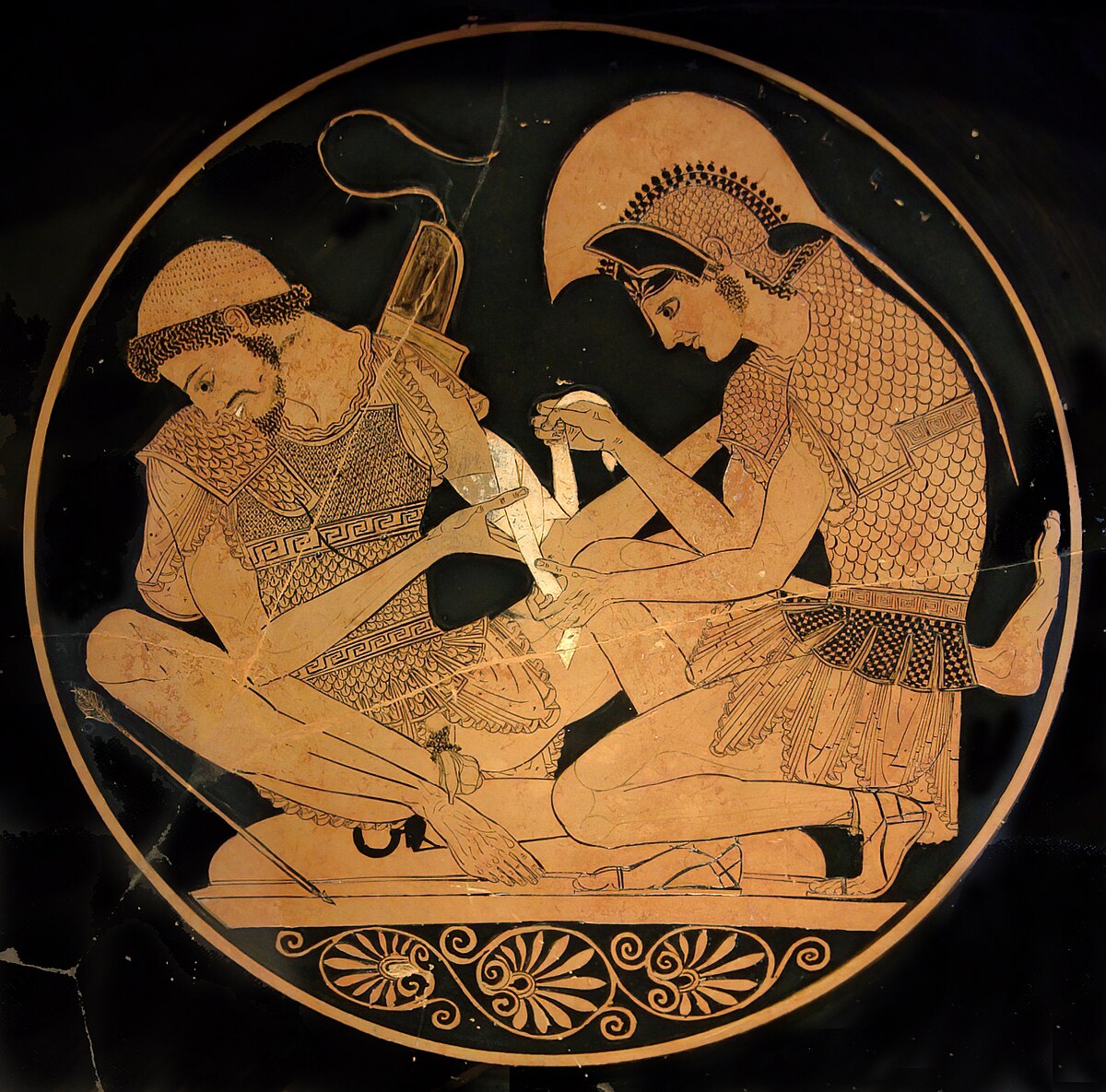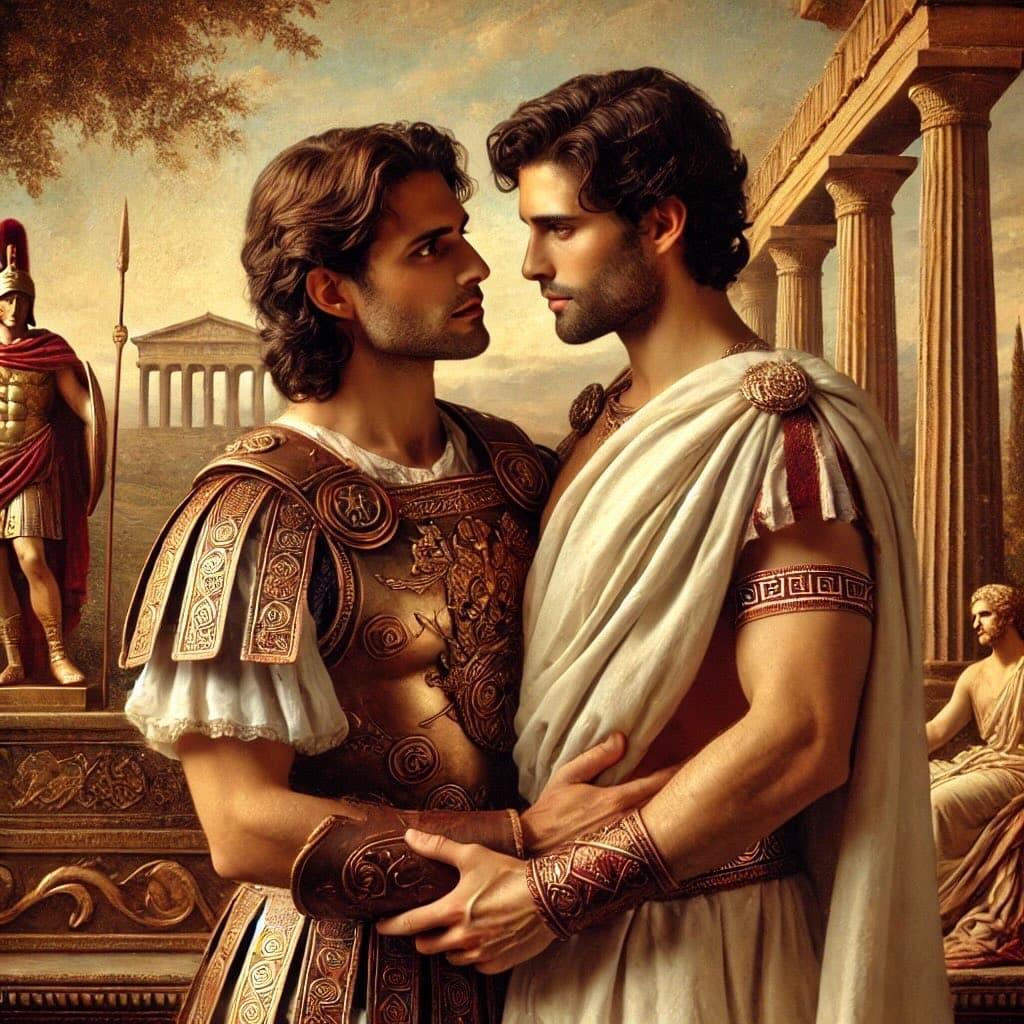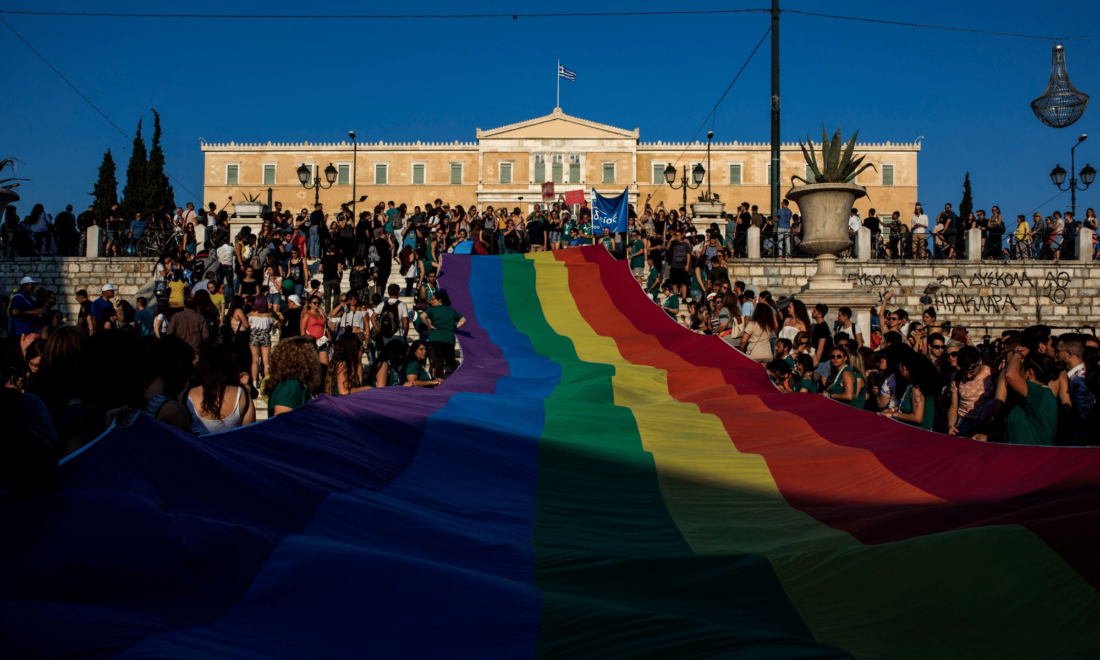Gays in Ancient Greece
Were the Ancient Greeks Gay-Friendly? In this article, Gay in Ancient Greece, we will briefly explain how life was gay back in Ancient Greece. Furthermore, we will reveal some characteristics of Greek society, such as pederasty, some famous ancient Greek gays, and much more. So, if you are interested in this topic, please stay with us.

©https://commons.wikimedia.org/wiki/File:Akhilleus_Patroklos_Antikensammlung_Berlin_F2278.jpg
Overview: Gays in Ancient Greece
Ancient Greece had different types of same-sex relationships: (a) pederasty, where young boys formed bonds with adult men; (b) relationships among young men of similar ages; (c) homosexual relationships among adult men; (d) relationships with age differences among women; and (e) relationships between adult women. Pederasty started because men tended to marry later, helping control population growth in the 7th century BCE. These relationships often occurred in sports and social events, focusing on mentorship.
In ancient Greece, writers like Herodotus and Plato talked about homosexuality, focusing on a practice called pederasty. It is a relationship between adult men and young boys, mainly among the elite. Some city-states accepted these relationships, while others did not. Adult men sometimes had sexual relationships, but those who took more passive roles often faced social challenges, though views on this can vary.
More importantly, the ancient Greeks did not view sexual orientation as we do today. They classified sexual behavior based on roles: the active partner was viewed as masculine and higher in status, while the passive partner was seen as feminine and lower in status. In the military, homosexual relationships were common and could help boost morale. Examples can be found in the Sacred Band of Thebes and the Spartan tradition, which valued strong emotional connections between soldiers.
Pederasty
In ancient Greece, the most common type of same-sex relationship among elite men was called pederasty. It involved an older man and a young male adolescent. A boy was considered a “boy” until he could grow a full beard. In Athens, the older man was known as the Erastes. He was responsible for educating, protecting, loving, and serving as a role model for his younger partner, the Eromenos. The younger partner brought beauty, youth, and potential as rewards for the older man.
Archaeologists have found evidence supporting this relationship pattern. For example, they discovered a bronze plaque showing an older man with a bow and arrow holding onto a younger man carrying a goat. The plaque also depicts the younger man’s exposed genitals. Experts interpret this and similar findings as evidence of the practice of pederasty.
Pederasty in Sparta
Most of what we know about pederasty in Sparta comes from texts written by outside observers. Plato’s Laws indicate that homosexuality was not only accepted but widely practiced in Sparta’s warrior culture. Historians debate the nature of Spartan pederasty. Some think it was more innocent than in other parts of Greece, while others see no real difference.
Xenophon explains that relationships between adult men and boys were acceptable if based on friendship and love. However, purely sexual attraction was considered wrong. Plutarch states that boys could form sexual relationships with older males when they reached puberty. Aelian talks about the responsibility of older citizens to guide younger, inexperienced males.
Historian Thomas F. Scanlon argues that Sparta was among the first cities to adopt athletic nudity and formalize pederasty. Erastês, or adult men, were seen as guardians of the erômenos, or young boys, and were responsible for their behavior. Paul Cartledge highlights that while pederastic relationships had a moral and educational role, sexual relations likely occurred, though their nature is still unclear. Plutarch notes that in the agōgē training program, they introduced boys around 12 to older lovers.
Athenian laws
In ancient Athens, views on male love were complicated. Many Athenians accepted men being attracted to each other. Still, they had concerns about men taking submissive roles, which seemed unworthy of a free citizen. Unlike other city-states such as Sparta, Athens tried to limit pederasty. However, it wasn’t so much about age differences but more about discomfort with homosexuality itself.
Plato argued in his work “Laws” that homosexuality is unnatural, claiming male animals only mate with females. This idea influenced Greek society significantly. Similarly, Aristotle and Xenophon believed men must take a dominant, heterosexual role. Notably, these philosophers did not see a difference between sex and reproduction, ignoring the modern idea that people can seek pleasure and form relationships based on their identities.
Homosexuality in Boeotia
Philolaus of Corinth, who loved the Stadion race winner Diocles, made laws in the 8th century BC that supported male relationships in Thebes. This approach allowed these unions to continue after the younger partner grew up. Plutarch stated that Theban pederasty aimed to soften boys’ natural fierceness. The Sacred Band of Thebes was made up of such couples. In contrast, Boeotian pottery does not show clear examples of pederastic themes like Athenian pottery. Its limited survival makes it hard to identify a unique local tradition regarding pederasty.
The love between adult men
Kenneth Dover, a classicist, wrote “Greek Homosexuality” in 1978. He explained that Greek society valued adult male masculinity and viewed the passive partner in same-sex relationships as feminized and socially stigmatized. This stigma mainly affected the passive partner, who was often ridiculed in plays by Aristophanes.
In contrast, Philolaus of Corinth, who loved Olympic champion Diocles around 728 BC, created laws that supported male unions. This helped develop Theban pederasty, where relationships could continue even after the younger partner became an adult. A famous example is the Sacred Band of Thebes, which comprised pairs of male lovers who were elite soldiers. Additionally, the relationship between Pausanias and Agathon in Plato’s “Symposium” lasted beyond its initial pederastic phase into adulthood.
Famous Gays in Ancient Greece
Achilles and Patroclus
The Iliad, written around 800 BC, shows a deep emotional bond between two adult men, Achilles and Patroclus. However, Homer does not describe their relationship as sexual. The ancient Athenians highlighted the age difference by illustrating Patroclus with a beard while Achilles is clean-shaven. Achilles was seen as a nearly godlike figure, which led to debates among respected figures like Aeschylus and Pausanias about who the older lover (Erastes) was and who the younger (Eromenos) was. According to Homer, Patroclus appears older, but Achilles is stronger. However, it is noted that the way characters are shown in pottery may not reflect reality and could instead follow the beauty standards of ancient Athens. Other ancient writers, such as Xenophon, considered Achilles and Patroclus close friends.

©threads.net/@bgaycom
Alexander and Hephaestion
Alexander the Great had a close bond with his cavalry commander and childhood friend, Hephaestion. Hephaestion was considered “the dearest of all the king’s friends.” Their friendship lasted throughout their lives and was often compared to that of Achilles and Patroclus.
The philosopher Aristotle studied both Alexander and Hephaestion. They are first mentioned in history during Alexander’s visit to Troy, where they sacrificed to honor Achilles and Patroclus.
After Hephaestion died in October 324 BC, Alexander was heartbroken and did not eat for several days. He hosted a grand funeral for Hephaestion and asked the priests at the shrine of Ammon to grant him divine honors. They refused but offered him the status of a divine hero. Alexander received this news shortly before his death, and some believe that his grief made him careless about his health.
Moreover, Alexander was so overwhelmed with sadness that he lay on Hephaestion’s body in tears for nearly a whole day, refusing to leave until his companions pulled him away. While some claim their relationship was romantic, others, like Adonis Georgiades, argue that Hephaestion was just a close friend.
So, were the Ancient Greeks Gay-Friendly?
To understand how ancient Greeks viewed sexuality, we need to examine history without modern biases. Historical sources can teach us valuable lessons, even if they differ from today’s views. For example, in Aristophanes’ play Lysistrata, Athenian women withhold sex from their husbands to end the war, showing that men are mainly heterosexual. Accounts from Persian and Indian historians also show that Alexander the Great’s soldiers missed their Greek wives.
The ancient Greek view of same-sex attraction is more complicated than often thought. Opinions on pederasty, or relationships between adult men and adolescent boys, varied by city-state and changed over time. In democratic Athens, men started marrying younger, and society accepted fewer non-marital relationships. Some philosophers even called male-male relationships “against nature.”
Today, we question whether boys in ancient Greece could consent to intimate relationships with adult men. Modern law sees boys as unable to give consent until after puberty. While some ancient critics worried about the effects of pederasty, most Greeks viewed adolescent boys as naturally sexual. Nudity in sports reflected this openness about their bodies. Evidence suggests that boys could refuse advances from adult men or choose to end those relationships.
Take a look at

Our Gay Athens Guide
Athens is an ideal travel destination for the LGBT+ community, with a vibrant nightlife and welcoming environment. Our Gay Athens

Our guide to gay Rome
In our guide to gay Rome, we have combined our gay travel experiences with those of some leading gay travelers
Photo credits:
Feature photo credits: ©threads.net/@bgaycom
